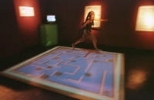Since Thinkapalooza opened at the MIT Museum, security guards report difficulty in emptying the exhibition at night. Visitors can't seem to tear themselves away from this new interactive zone, which offers high-tech adventurers of all ages the opportunity to explore an array of technological innovations from the labs of MIT.
One of the most popular components of Thinkapalooza is the "Metafield Maze." Based on the hand-held maze games that require a player to roll a marble through a labyrinth avoiding an obstacle course of holes, Metafield Maze is a virtual reality game in which participants use their bodies to direct the movement of an imaginary marble through a human-sized maze.
Metafield Maze was invented and created by Ron MacNeil and Bill Keays of the Media Lab, with contributions from Tim McNerney and John Underkoffer. The maze is a computer-generated image projected onto the floor by a ceiling-mounted video projector. When the player steps into the maze, the computer analyzes his or her image using a video camera mounted near the projector. The computer then defines body shape, finds its center, and uses that center point as a cursor to tilt the floor of the maze. As the player moves, the center point shifts. The floor appears to tilt in response, thereby rolling the virtual marble through the maze.
In the "Musical Intuitions" section of Thinkapalooza, visitors can use "tuneblocks," short musical phrases, to create familiar tunes or invent new ones with a computer program called Impromptu. Conceived by Jeanne Bamberger, Professor of Music and Urban Education at MIT, Impromptu illustrates just how humans make sense of music.
'INVENTION DIMENSION'
In Thinkapalooza's "Invention Dimension," a celebration of American ingenuity sponsored by the Lemelson-MIT Program, visitors can probe the minds of inventors, explore the inventive process, enter an invention trivia contest and learn how to patent and market their own inventions.
The Invention Dimension web site in Thinkapalooza was featured in Popular Science's October cover story as one of the "50 Hot Sci-Tech Sites," with the assertion that "MIT's Invention Dimension enchants, inspires, and entertains emerging Edisons and simple gadget fanatics alike... this is an ideal gateway to online innovation information." The Lemelson-MIT Program is administered by the MIT Sloan School of Management and is part of the Lemelson National Program in Invention, Innovation, and Creativity.
When visitors to Thinkapalooza aren't making music, negotiating the maze or taking the Invention Dimension trivia challenge, they can be found creating monsters and machines with Toobers&Zots, the foam construction toy conceived by MIT Artist-in-Residence Arthur Ganson. HandsOn Toys, the makers of Toobers&Zots, designed the Toobers&Zots sign for Thinkapalooza and helped children from the Haggerty School in Cambridge create 3-D sculptures for this new museum space.
Thinkapalooza is a long-term installation at the museum, located at 265 Massachusetts Avenue (Building N52). For more information, call x3-4444.
A version of this article appeared in MIT Tech Talk on September 20, 2000.






